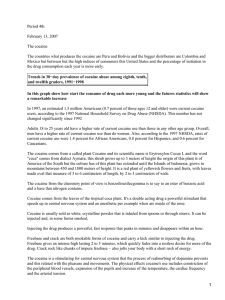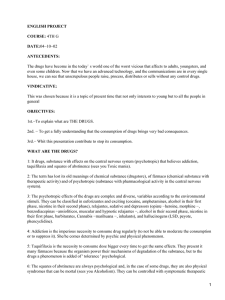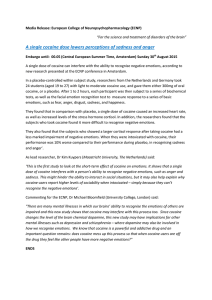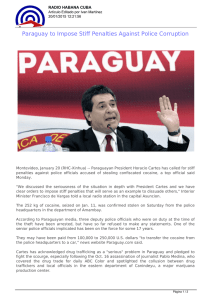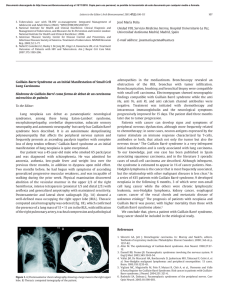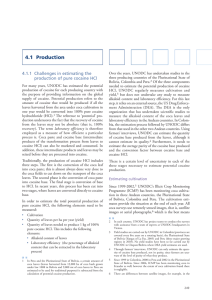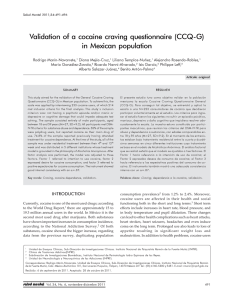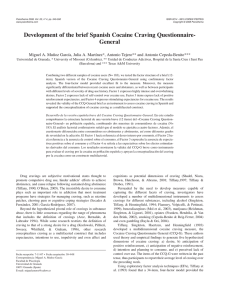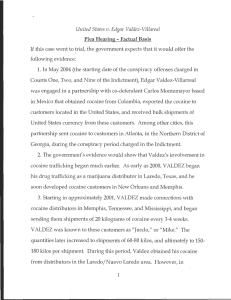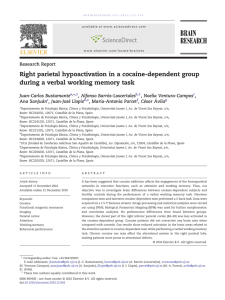Individual Characteristics And Response To
Anuncio
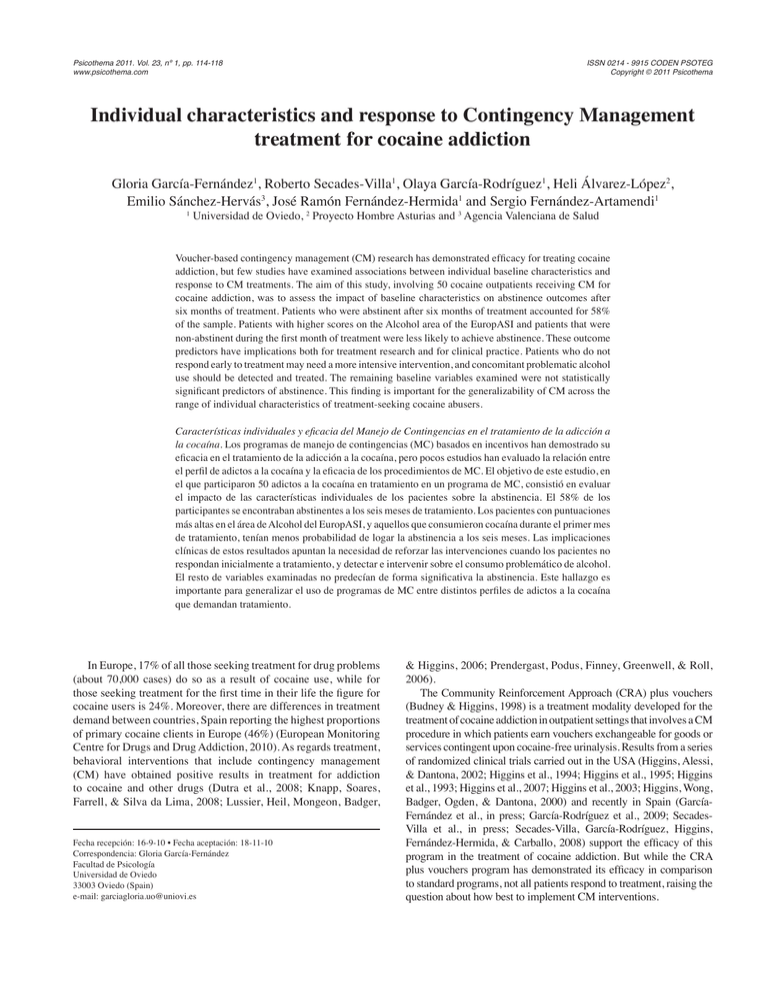
Psicothema 2011. Vol. 23, nº 1, pp. 114-118 www.psicothema.com ISSN 0214 - 9915 CODEN PSOTEG Copyright © 2011 Psicothema Individual characteristics and response to Contingency Management treatment for cocaine addiction Gloria García-Fernández1, Roberto Secades-Villa1, Olaya García-Rodríguez1, Heli Álvarez-López2, Emilio Sánchez-Hervás3, José Ramón Fernández-Hermida1 and Sergio Fernández-Artamendi1 1 Universidad de Oviedo, 2 Proyecto Hombre Asturias and 3 Agencia Valenciana de Salud Voucher-based contingency management (CM) research has demonstrated efficacy for treating cocaine addiction, but few studies have examined associations between individual baseline characteristics and response to CM treatments. The aim of this study, involving 50 cocaine outpatients receiving CM for cocaine addiction, was to assess the impact of baseline characteristics on abstinence outcomes after six months of treatment. Patients who were abstinent after six months of treatment accounted for 58% of the sample. Patients with higher scores on the Alcohol area of the EuropASI and patients that were non-abstinent during the first month of treatment were less likely to achieve abstinence. These outcome predictors have implications both for treatment research and for clinical practice. Patients who do not respond early to treatment may need a more intensive intervention, and concomitant problematic alcohol use should be detected and treated. The remaining baseline variables examined were not statistically significant predictors of abstinence. This finding is important for the generalizability of CM across the range of individual characteristics of treatment-seeking cocaine abusers. Características individuales y eficacia del Manejo de Contingencias en el tratamiento de la adicción a la cocaína. Los programas de manejo de contingencias (MC) basados en incentivos han demostrado su eficacia en el tratamiento de la adicción a la cocaína, pero pocos estudios han evaluado la relación entre el perfil de adictos a la cocaína y la eficacia de los procedimientos de MC. El objetivo de este estudio, en el que participaron 50 adictos a la cocaína en tratamiento en un programa de MC, consistió en evaluar el impacto de las características individuales de los pacientes sobre la abstinencia. El 58% de los participantes se encontraban abstinentes a los seis meses de tratamiento. Los pacientes con puntuaciones más altas en el área de Alcohol del EuropASI, y aquellos que consumieron cocaína durante el primer mes de tratamiento, tenían menos probabilidad de logar la abstinencia a los seis meses. Las implicaciones clínicas de estos resultados apuntan la necesidad de reforzar las intervenciones cuando los pacientes no respondan inicialmente a tratamiento, y detectar e intervenir sobre el consumo problemático de alcohol. El resto de variables examinadas no predecían de forma significativa la abstinencia. Este hallazgo es importante para generalizar el uso de programas de MC entre distintos perfiles de adictos a la cocaína que demandan tratamiento. In Europe, 17% of all those seeking treatment for drug problems (about 70,000 cases) do so as a result of cocaine use, while for those seeking treatment for the first time in their life the figure for cocaine users is 24%. Moreover, there are differences in treatment demand between countries, Spain reporting the highest proportions of primary cocaine clients in Europe (46%) (European Monitoring Centre for Drugs and Drug Addiction, 2010). As regards treatment, behavioral interventions that include contingency management (CM) have obtained positive results in treatment for addiction to cocaine and other drugs (Dutra et al., 2008; Knapp, Soares, Farrell, & Silva da Lima, 2008; Lussier, Heil, Mongeon, Badger, Fecha recepción: 16-9-10 • Fecha aceptación: 18-11-10 Correspondencia: Gloria García-Fernández Facultad de Psicología Universidad de Oviedo 33003 Oviedo (Spain) e-mail: [email protected] & Higgins, 2006; Prendergast, Podus, Finney, Greenwell, & Roll, 2006). The Community Reinforcement Approach (CRA) plus vouchers (Budney & Higgins, 1998) is a treatment modality developed for the treatment of cocaine addiction in outpatient settings that involves a CM procedure in which patients earn vouchers exchangeable for goods or services contingent upon cocaine-free urinalysis. Results from a series of randomized clinical trials carried out in the USA (Higgins, Alessi, & Dantona, 2002; Higgins et al., 1994; Higgins et al., 1995; Higgins et al., 1993; Higgins et al., 2007; Higgins et al., 2003; Higgins, Wong, Badger, Ogden, & Dantona, 2000) and recently in Spain (GarcíaFernández et al., in press; García-Rodríguez et al., 2009; SecadesVilla et al., in press; Secades-Villa, García-Rodríguez, Higgins, Fernández-Hermida, & Carballo, 2008) support the efficacy of this program in the treatment of cocaine addiction. But while the CRA plus vouchers program has demonstrated its efficacy in comparison to standard programs, not all patients respond to treatment, raising the question about how best to implement CM interventions. INDIVIDUAL CHARACTERISTICS AND RESPONSE TO CONTINGENCY MANAGEMENT TREATMENT FOR COCAINE ADDICTION Progress has been made in identifying predictors of successful cocaine treatment outcomes, but although a few variables have been found to be associated with poor treatment outcome, including cocaine-use variables, baseline urine cocaine results, cocaine withdrawal symptoms, comorbid depression, alcohol use and impulsivity, there are mixed findings among different trials, making it difficult to identify robust predictors (Poling, Kosten, & Sofuoglu, 2007). Moreover, while CM outcome research continues to grow, relatively few studies have examined associations between individual-level characteristics and response to CM treatments. In recent studies it was found that income does not affect CM efficacy (Rash, Olmstead, & Petry, 2009), and that the effectiveness of abstinence-based incentives interacts with intake stimulant urinalysis results (Stitzer et al., 2007). Other recent research has explored associations between individual characteristics such as PTSD symptoms and outcomes in CM, finding that patients with PTSD entering CM for cocaine dependence are not at increased risk for substance use (Burns, Lehman, Milby, Wallace, & Schumacher, 2010). In the same direction, prize-based contingency management was found to be efficacious in cocaine-abusing patients with and without recent gambling participation (Petry & Alessi, 2010). On the other hand, only a few studies have examined predictive factors of success in CM cocaine treatments in settings other than that of the USA, and they have focused on prediction of retention rather than on cocaine abstinence (García-Rodríguez et al., 2007; Santonja-Gómez et al., 2010). Sound predictors of success in CM cocaine treatments are necessary for understanding how individual differences affect treatment outcomes and increase success rates. This would make it possible to identify those patients in whom treatment is ineffective, direct CM approaches toward those patients most likely to benefit, and analyze the generalizability of CM across patients. This study focuses on the identification of potential predictors of successful abstinence outcomes in an outpatient treatment program involving CM procedures for cocaine addicts in Spain. Specifically, we assessed whether individual baseline characteristics (including sociodemographic characteristics, addiction severity, cocaine use during first 4 weeks of treatment, psychosocial functioning and psychopathological variables) affect abstinence outcomes at six months of treatment and examined the impact of patients’ characteristics on the effectiveness of CM. Method Participants Inclusion criteria were being at least 20 years old, meeting Diagnostic and Statistical Manual of Mental Disorders (Revised Fourth Edition) criteria for active cocaine dependence (American Psychiatric Association, 2000), and not presenting serious psychopathological disorders (such as psychosis or dementia) or active opioid dependence. The sample results from a combined dataset from two randomized clinical trials designed with parallel procedural elements. The two studies shared the same population (cocainedependent adults seeking outpatient treatment), recruitment methods and data-collection schedules, and both involved CRA plus vouchers outpatient treatment and measures. There were no differences in participants’ baseline characteristics across studies. 115 The final sample was made up of 50 patients (82% males), with a mean age of 31.4 years (SD= 6.0). Average years of regular cocaine use was 6.93 (SD= 4.72), and 96% of the sample used the intranasal route of cocaine administration. Seventy-four percent of the sample presented problematic use of alcohol, and 46% used cannabis. Instruments Patients were informed about the treatment intervention characteristics, the urinalysis monitoring and the assessments schedule before being asked to give informed consent. Assessments were carried out at intake, participants being asked to complete several instruments, including the Michigan Alcoholism Screening Test (MAST) (Selzer, 1971), the Beck Depression Inventory (BDI) (Beck, Ward, Mendelson, Mock, & Erbaugh, 1961), the Cocainedependence criteria of the DSM-IV-TR (American Psychiatric Association, 2000), the European version of the Addiction Severity Index, the EuropASI (Díaz Mesa et al., 2010; Kokkevi & Hartgers, 1995), and the Symptom Checklist-90-Revised (SCL90-R) (Derogatis, 1983). Urine specimens were screened on-site for the detection of cocaine use by means of the Quickscreen Test by the Perfelena Company (Madrid). The Quickscreen test is a chromatographic immunoassay that rapidly detects patients’ cocaine use. The reagents in this test detect benzoylecgonine (a cocaine metabolite) at a concentration of 300ng/mL. Variables The primary treatment outcome variable for analysis was cocaine abstinence at six months of treatment (point-prevalence abstinence). Abstinence at the 6-month assessment was validated by means of concordance between urine toxicology, patient selfreports and family reports (agreement was needed between all three measures). Patients lost during the 6-month period were considered non-abstinent. Missing urine samples were considered positive, which is a recommended method for dealing with missing data in substance abuse treatment research. The predictor variables used in the analysis were: sociodemographic (gender, age, years of education, marital status, employment and served time in prison); addiction severity (administration route, years of cocaine use, other regular drug abuse in lifetime and MAST scores); psychological functioning (EuropASI composite scores); psychopathological profile (SCL90-R and BDI scores); and early treatment cocaine use, defined as positive urine analysis at week 4 of treatment (1-month pointprevalence). CRA plus vouchers treatment The CRA was implemented according to the manual published by Budney and Higgins (Budney & Higgins, 1998) and was made up of five components: drug avoidance skills; lifestyle change; relationship counseling; other substance abuse; and other psychiatric problems. Urine specimens were screened three times a week from weeks 1 to 12, and twice a week from weeks 13 to 24 in accordance with the original format of the CRA plus vouchers program. Patients were informed of their urinalysis results immediately after 116 GLORIA GARCÍA-FERNÁNDEZ, ROBERTO SECADES-VILA, OLAYA GARCÍA-RODRÍGUEZ, HELI ÁLVAREZ-LÓPEZ, EMILIO SÁNCHEZ-HERVÁS, JOSÉ RAMÓN FERNÁNDEZ-HERMIDA AND SERGIO FERNÁNDEZ-ARTAMENDI submitting their specimens and received incentives in exchange for maintaining abstinence. The main details of the voucher program implementation have been described previously (Budney & Higgins, 1998; Secades-Villa et al., 2008). Points were exchangeable for vouchers that allowed participants to acquire a variety of goods or services compatible with a drug-free lifestyle. All these goods and services were financed through collaborating institutions from the community and companies (García-Rodríguez, Secades-Villa, Higgins, Fernández-Hermida, & Carballo, 2008). All the incentives selected by the participants had to be approved by the therapist and deemed to be in accordance with individual treatment goals. We conducted a logistic regression analysis to examine the usefulness of week-4 cocaine urinalysis results and Alcohol Composite scores of the EuropASI for predicting the likelihood of cocaine abstinence at six months of treatment. The full model containing both predictors was statistically significant [χ2 (2, n= 50) = 13.67, p= .00], indicating that the model was able to distinguish between participants who were abstinent and non-abstinent after six months of CRA + vouchers treatment. The model as a whole explained between 23.9% (Cox and Snell R square) and 32.2% (Nagelkerke R square) of the variance in cocaine abstinence status, and correctly classified 76% of cases. As shown in Table 2, both independent variables made statistically significant contributions to Data analysis Various descriptive and frequency analyses in relation to participants’ characteristics were carried out. Comparisons between the groups from the two clinical trials in baseline characteristics were calculated using either 2-sample t tests for continuous variables or χ2 tests for categorical variables. The number of potential predictor variables was reduced by testing for statistical significant differences between baseline characteristics of abstinent and nonabstinent participants at six months of treatment follow-up using χ2 tests for categorical variables and independent t tests for continuous variables. A logistic regression analysis was conducted to examine the usefulness of baseline participants’ characteristics (independent variables) in predicting likelihood of cocaine abstinence at six months of treatment (dependent variable). Confidence level used was 95%. The statistical software package SPSS-15 was used for the analysis. Results Participant characteristics and abstinence rates Patients that were abstinent at six months of treatment accounted for 58% of the sample (n= 29). Abstinent and nonabstinent participants were compared in all studied variables in order to assess variables related to abstinence. Comparison data are shown in Table 1. Results showed that there were only statistically significant differences between the two groups on Alcohol EuropASI composite scores and on cocaine use during week 4 of treatment (1-month point prevalence). Patients that were non-abstinent after six months of treatment scored significantly higher on the Alcohol area of the EuropASI compared to abstinent participants [t (48)= -2.51, p= .01], and 96.6% of participants that provided a negative cocaine toxicology sample during week 4 of treatment (28 of 29) were abstinent after six months of treatment [χ2 (1, n= 50)= 6.02, p= .01]. For all the other variables examined there were no significant differences between the abstinence groups. Factors associated with abstinence As there was no statistically significant relationship between 6-month cocaine abstinence and most participants’ baseline variables, only the Alcohol EuropASI scores and cocaine urinalysis results after one month of treatment were considered as predictive factors for cocaine abstinence. Table 1 Baseline characteristics of abstinent and non-abstinent participants Participants (N= 50) Abstinent (N= 29) Nonabstinent (N= 21) p Demographics Gender (% male) Age, yearsa Education, yearsa Marital status (% never married) Employed Served time in prison (%) 79.3 30.5 ± 5.4 10.1 ± 2.0 51.7 51.7 13.8 85.7 32.6 ± 6.7 10.4 ± 3.0 47.6 66.7 15.0 .83 .22 .66 .56 .44 1 Cocaine use Intranasal route (%) Years of regular cocaine usea 100 6.5 ± 4.5 90.5 7.5 ± 5.0 .33 .45 Other drug abuse in lifetimeb (%) Alcohol Cannabis Amphetamines 69.0 47.6 17.2 81.0 44.8 10.0 .53 1 .76 5.3 ± 4.8 7.2 ± 4.1 .15 ASI Composite Scoresa Medical Employment Alcohol Drugs Legal Family/social Psychiatric 0.22 ± 0.27 0.38 ± 0.32 0.24 ± 0.21 0.20 ± 0.10 0.12 ± 0.21 0.36 ± 0.19 0.22 ± 0.23 0.22 ± 0.27 0.31± 0.30 0.40 ± 0.22 0.19 ± 0.08 0.14 ± 0.21 0.32 ± 0.18 0.35 ± 0.23 .97 .44 .01 .69 .70 .50 .06 SCL-90-Ra Somatization Obsessive-Compulsive Interpersonal sensitivity Depression Anxiety Hostility Phobic anxiety Paranoid ideation Psychoticism Global severity Positive symptom distress Positive symptom total 60.5 ± 38.3 74.4 ± 32.4 63.2 ± 37.3 69.6 ± 34.0 63.5 ± 37.0 53.6 ± 34.5 60.5 ± 39.9 56.2 ± 41.4 68.7 ± 31.8 68.7 ± 35.7 69.0 ± 35.0 65.3 ± 28.2 58.1 ± 37.6 76.4 ± 28.8 68.5 ± 31.6 69.9 ± 32.7 66.4 ± 35.0 65.1 ± 31.9 62.8 ± 37.3 68.6 ± 31.8 72.8 ± 29.2 74.4 ± 31.2 77.1 ± 27.7 69.0 ± 31.8 .82 .82 .59 .97 .78 .23 .84 .23 .64 .56 .36 .66 13.3 ± 6.9 15.2 ± 8.3 .38 3.4 33.3 .01 Variables MAST scorea BDI scorea Week-4 cocaine urinalysisc Positive (%) Means SD Three or more times per week, binges, or problematic irregular use in which normal activities are compromised c 1-month point prevalence a b INDIVIDUAL CHARACTERISTICS AND RESPONSE TO CONTINGENCY MANAGEMENT TREATMENT FOR COCAINE ADDICTION the model. The strongest predictor of achieving cocaine abstinence was 1-month point prevalence, with an odds ratio of 14.9. This indicated that participants who were abstinent after one month of treatment were over 14 times more likely to be abstinent after six months of treatment than those who used cocaine at week 4 of treatment. The odds ratio of .03 for Alcohol EuropASI composite scores was less than 1, indicating that for every additional higher score on this scale, participants were 0.03 times less likely to report achieving cocaine abstinence after six months of treatment. Table 2 Logistic Regression Analysis Predicting Likelihood of Cocaine Abstinence Independent variable ASI Alcohol CS a b Week-4 cocaine urinalysis a B (SE) Wald Odds ratio 95% lower CI upper p -3.37 (1.57) 4.58 .03 .00 .75 .03 2.70 (1.18) 5.23 14.9 1.47 151.7 .02 EuropASI Alcohol Composite Score 1-Month point prevalence b Discussion The main objective of this study was to analyze abstinence outcomes in cocaine outpatients receiving a CM intervention, and to determine which variables affect patients’ abstinence. The global abstinence rate after six months of treatment was 58% of the sample, which is consistent with CRA plus vouchers treatment outcomes in previous studies (Higgins et al., 1995; Higgins et al., 1993). The predictive analysis showed that the result of week-4 cocaine urinalysis testing was predictive of abstinence outcomes at the six-month follow-up. This finding is consistent with results of previous clinical trials highlighting how success in attaining early abstinence in treatment moderates the outcome of CM interventions (Stitzer, Petry, & Peirce, 2010; Stitzer et al., 2007; Weinstock, Rash, & Petry, 2010). In the same direction, the achievement of longer periods of abstinence during treatment has also been found to be associated with posttreatment abstinence among cocainedependent outpatients (Higgins, Badger, & Budney, 2000). Failure to attain abstinence at the beginning of CM treatment appears to be an indicator of poorer outcomes, indicating the need to identify timeframes over which CM is effective. In one of the studies mentioned above (Weinstock et al., 2010), patients who responded to CM attained abstinence during the first weeks of treatment, and few participants initiated any period of abstinence after week 4. Therefore, the first 4 weeks of treatment were considered to be an appropriate timeframe for monitoring initial patient response to CM interventions, and for considering alternative treatment options for those who not respond to treatment. Possible alternatives suggested included increasing the value of vouchers; combining CM with behavioral contingencies for counseling attendance; abstinence initiation bonuses; increasing number of visits; or implementing other treatment alternatives over and above CM interventions (e.g., intensive outpatient treatment, pharmacological treatment or inpatient treatment) (Tzilos, Rhodes, Ledgerwood, & Greenwald, 2009; Weinstock et al., 2010). Furthermore, results showed that problems associated with concomitant alcohol use also predicted treatment abstinence outcomes. Alcohol abuse has been associated with more severe 117 cocaine dependence and use of other drugs in cocaine-dependent outpatients, though there are contradictory findings about whether concomitant alcohol use predicts negative treatment outcome (Poling et al., 2007). Our finding is consistent with previous studies indicating that those who use cocaine and alcohol had poorer outcomes in standard treatments for cocaine addiction than those who use only cocaine (Fernández-Montalvo & López-Goñi, 2010; McKay, Alterman, Rutherford, Cacciola, & McLellan, 1999; Schmitz, Bordnick, Kearney, Fuller, & Breckenridge, 1997). The remaining participant characteristics examined (sociodemographic variables, drug use variables, psychopathological profile and psychological functioning) were not statistically significant different between abstainers and nonabstainers, and did not have an impact on treatment outcomes. Therefore, these variables may not negatively affect CM treatment outcomes, and the implementation of CRA plus vouchers program for cocaine addiction may not be limited to a certain patient profile. In this regard, recent studies have demonstrated that some individual differences, including those related to socioeconomic variables, recent gambling or psychopathological disorders such as antisocial personality disorder, do not affect CM efficacy (Messina, Farabee, & Rawson, 2003; Petry & Alessi, 2010; Rash et al., 2009). Moreover, in another recent study of cocaine group treatment outcome in methadone maintenance patients (Tzilos et al., 2009), it was found that successful patients were not qualitatively different from treatment-resistant patients, and differences were found only in baseline cocaine-free urinalysis and higher methadone dose. Thus, it was argued that early abstainers could be simply more sensitive to CM intervention, and increasing therapy doses may overcome this group difference. We conclude that cocaine-positive urinalysis at week 4 of treatment and concomitant problematic alcohol use at baseline are associated with poorer treatment outcomes in cocaine-dependent patients receiving CRA plus vouchers program. These outcome predictors may have implications both for treatment research and for clinical practice. Patients who do not respond early to CM treatment may need a more intensive intervention, and complementary intervention strategies should be implemented to detect and treat concomitant problematic alcohol use in order to achieve higher abstinence rates. Finally, the limitations of the present study include the fact that the sample is not very large, affecting the validity of the data; the need for more potential predictor variables to be examined, especially those most specifically related to the treatment; and the fact that we cannot attribute outcomes to the CM component of treatment and/ or the content of CRA intervention. On the other hand, the fact that participants came from a multi-study dataset in different communitybased clinics increases the generalizability of the findings. More research exploring cocaine treatment predictors and the action mechanisms of treatment programs should be carried out, with a view not only to improving treatment retention and abstinence, but also to allaying concerns about the effectiveness of CM among different substance abusers for disseminating information about and increasing the use of this evidence-based program. Acknowledgements This project was funded by the Spanish National Plan on Drugs (PNsD) (Ref. MSC-06-01) and supported by a predoctoral grant from the University of Oviedo (Ref. UNOV-08-BECDOC). 118 GLORIA GARCÍA-FERNÁNDEZ, ROBERTO SECADES-VILA, OLAYA GARCÍA-RODRÍGUEZ, HELI ÁLVAREZ-LÓPEZ, EMILIO SÁNCHEZ-HERVÁS, JOSÉ RAMÓN FERNÁNDEZ-HERMIDA AND SERGIO FERNÁNDEZ-ARTAMENDI References American Psychiatric Association (2000). Diagnostic and Statistical Manual of Mental Disorders (4th ed. revised). Washington, D.C.: American Psychiatric Association. Beck, A.T., Ward, C.H., Mendelson, M., Mock, J., & Erbaugh, J. (1961). An inventory for measuring depression. Archives of General Psychiatry, 4, 561-571. Budney, A.J., & Higgins, S.T. (1998). A Community Reinforcement Plus Vouchers Approach: Treating Cocaine Addiction. Rockville: National Institute on Drug Abuse. Burns, M.N., Lehman, K.A., Milby, J.B., Wallace, D., & Schumacher, J.E. (2010). Do PTSD symptoms and course predict continued substance use for homeless individuals in contingency management for cocaine dependence? Behaviour Research and Therapy, 48(7), 588-598. Derogatis, L.R. (1983). SCL-90-R, administration, scoring and procedures Manual II for the Revised Version of the SCL-90. Baltimore: Johns Hopkins University Press. Díaz Mesa, E.M., García-Portilla, P., Sáiz, P.A., Bobes Bascarán, T., Casares, M.J., Fonseca, E., et al. (2010). Rendimiento psicométrico de la sexta versión del Addiction Severity Index en español (ASI-6). Psicothema, 22(3), 513-519. Dutra, L., Stathopoulou, G., Basden, S.L., Leyro, T.M., Powers, M.B., & Otto, M.W. (2008). A meta-analytic review of psychosocial interventions for substance use disorders. American Journal of Psychiatry, 165, 179-187. European Monitoring Centre for Drugs and Drug Addiction (2010). Annual report 2010: The state of the drugs problem in Europe. Lisbon: EMCDDA. Fernández-Montalvo, J., & López-Goñi, J.J. (2010). Comparison of completers and dropouts in psychological treatment for cocaine addiction. Addiction Research and Theory, 18(4), 433-441. García-Fernández, G., Secades-Villa, R., García-Rodríguez, O., SánchezHervas, E., Fernández-Hermida, J.R., & Higgins, S.T. (in press). Adding voucher-based incentives to CRA improves outcomes during treatment for cocaine dependence. The American Journal on Addictions. García-Rodríguez, O., Secades-Villa, R., Álvarez Rodríguez, H., Río Rodríguez, A., Fernández-Hermida, J.R., Carballo, J.L., et al. (2007). Effect of incentives on retention in an outpatient treatment for cocaine addicts. Psicothema, 19(1), 134-139. García-Rodríguez, O., Secades-Villa, R., Higgins, S.T., FernándezHermida, J.R., & Carballo, J.L. (2008). Financing a voucher program for cocaine abusers through community donations in Spain. Journal of Applied Behavior Analysis, 41(4), 623-628. García-Rodríguez, O., Secades-Villa, R., Higgins, S.T., FernándezHermida, J.R., Carballo, J.L., Errasti Pérez, J.M., et al. (2009). Effects of voucher-based intervention on abstinence and retention in an outpatient treatment for cocaine addiction: A randomized controlled trial. Experimental and Clinical Psychopharmacology, 17(3), 131-138. Higgins, S.T., Alessi, S.M., & Dantona, R.L. (2002). Voucher-based incentives. A substance abuse treatment innovation. Addictive Behaviors, 27(6), 887-910. Higgins, S.T., Badger, G.J., & Budney, A.J. (2000). Initial abstinence and success in achieving longer term cocaine abstinence. Experimental and Clinical Psychopharmacology, 8(3), 377-386. Higgins, S.T., Budney, A.J., Bickel, W.K., Foerg, F.E., Donham, R., & Badger, G.J. (1994). Incentives improve outcome in outpatient behavioral treatment of cocaine dependence. Archives of General Psychiatry, 51(7), 568-576. Higgins, S.T., Budney, A.J., Bickel, W.K., Foerg, F.E., Ogden, D., & Badger, G.J. (1995). Outpatient behavioral treatment for cocaine dependence: One-year outcome. Experimental and Clinical Psychopharmacology, 3(2), 205-212. Higgins, S.T., Budney, A.J., Bickel, W.K., Hughes, J.R., Foerg, F., & Badger, G. (1993). Achieving cocaine abstinence with a behavioral approach. American Journal of Psychiatry, 150(5), 763-769. Higgins, S.T., Heil, S.H., Dantona, R., Donham, R., Matthews, M., & Badger, G.J. (2007). Effects of varying the monetary value of voucherbased incentives on abstinence achieved during and following treatment among cocaine-dependent outpatients. Addiction, 102(2), 271-281. Higgins, S.T., Sigmon, S.C., Wong, C.J., Heil, S.H., Badger, G.J., Donham, R., et al. (2003). Community reinforcement therapy for cocaine- dependent outpatients. Archives of General Psychiatry, 60(10), 10431052. Higgins, S.T., Wong, C.J., Badger, G.J., Ogden, D.E., & Dantona, R.L. (2000). Contingent reinforcement increases cocaine abstinence during outpatient treatment and 1 year of follow-up. Journal of Consulting and Clinical Psychology, 68(1), 64-72. Knapp, W.P., Soares, B., Farrell, M., & Silva da Lima, M. (2008). Psychosocial interventions for cocaine and psychostimulant amphetamines related disorders (Review). The Cochrane Library, 3. Kokkevi, A., & Hartgers, C. (1995). European adaptation of a multidimensional assessment instrument for drug and alcohol dependence. European Addiction Research, 1, 208-210. Lussier, J.P., Heil, S.H., Mongeon, J.A., Badger, G.J., & Higgins, S.T. (2006). A meta-analysis of voucher based reinforcement therapy for substance use disorders. Addiction 101, 192-203. McKay, J.R., Alterman, A.I., Rutherford, M.J., Cacciola, J.S., & McLellan, A.T. (1999). The relationship of alcohol use to cocaine relapse in cocaine dependent patients in an aftercare study. Journal of Studies on Alcohol and Drugs, 60(2), 176-180. Messina, N., Farabee, D., & Rawson, R. (2003). Treatment responsivity of cocaine-dependent patients with antisocial personality disorder to cognitive-behavioral and contingency management interventions. Journal of Consulting and Clinical Psychology, 71(2), 320-329. Petry, N., & Alessi, S.M. (2010). Prize-based contingency management is efficacious in cocaine-abusing patients with and without recent gambling participation. Journal of Substance Abuse Treatment, 39, 282-288. Poling, J., Kosten, T.R., & Sofuoglu, M. (2007). Treatment outcome predictors for cocaine dependence. American Journal of Drug and Alcohol Abuse, 33(2), 191-206. Prendergast, M., Podus, D., Finney, J., Greenwell, L., & Roll, J. (2006). Contingency management for treatment of substance use disorders: A meta-analysis. Addiction, 101, 1546-1560. Rash, C.J., Olmstead, T.A., & Petry, N. (2009). Income does not affect response to contingency management treatments among community substance abuse treatment-seekers. Drug and Alcohol Dependence, 104(3), 249-253. Santonja-Gómez, F.J., Sánchez-Hervás, E., Secades-Villa, R., ZacarésRomaguera, M.A., García-Rodríguez, O., & García-Fernández, G. (2010). Pretreatment characteristics as predictors of retention in cocaine-dependent outpatients. Addictive Disorders and Their Treatment, 9(2), 93-98. Schmitz, J.M., Bordnick, P.S., Kearney, M.L., Fuller, S.M., & Breckenridge, J.K. (1997). Treatment outcome of cocaine-alcohol dependent patients. Drug and Alcohol Dependence, 47(1), 55-61. Secades-Villa, R., García-Rodríguez, O., García-Fernández, G., SánchezHervas, E., Fernández-Hermida, J.R., Higgins, S.T., et al. (in press). Community reinforcement approach plus vouchers among cocainedependent outpatients: Twelve-month outcomes. Psychology of Addictive Behaviors. Secades-Villa, R., García-Rodríguez, O., Higgins, S.T., Fernández-Hermida, J.R., & Carballo, J.L. (2008). Community reinforcement approach plus vouchers for cocaine dependence in a community setting in Spain: Sixmonth outcomes. Journal of Substance Abuse Treatment, 34(2), 202-207. Selzer, M.L. (1971). The Michigan alcoholism screening test: The quest for a new diagnostic instrument. American Journal of Psychiatry, 127(12), 1653-1658. Stitzer, M.L., Petry, N., & Peirce, J. (2010). Motivational incentives research in the National Drug Abuse Treatment Clinical Trials Network. Journal of Substance Abuse Treatment, 38(4), S61-S69. Stitzer, M.L., Petry, N., Peirce, J., Kirby, K., Killeen, T., Roll, J., et al. (2007). Effectiveness of abstinence-based incentives: Interaction with intake stimulant test results. Journal of Consulting and Clinical Psychology, 75(5), 805-811. Tzilos, G.K., Rhodes, G.L., Ledgerwood, D.M., & Greenwald, M.K. (2009). Predicting cocaine group treatment outcome in cocaine-abusing methadone patients. Experimental and Clinical Psychopharmacology, 17(5), 320-325. Weinstock, J., Rash, C.J., & Petry, N. (2010). Contingency management for cocaine use in methadone maintenance patients: When does abstinence happen? Psychology of Addictive Behaviors, 24(2), 282-291.
